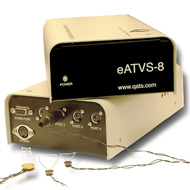How Thermal Engineers can Save Money on World Class Test Equipment for Thermal Analysis

Gone are the days when a simple heat sink, applied with thermal tape and coupled with a larger fan, are adequate for cooling electronic systems. Instead, complex air flows in systems have to be detected, temperature gradients must be identified, and hot spots accounted for in a system wide thermal analysis. This data is then used to create a system level thermal management solution to manage chip junction temperatures. But, data must be collected first to create such a solution.
 ATS’s eATVS-4, coupled with its omnidirectional Candlestick sensors, and fully automated stageVIEW data acquisition and reporting software, are the perfect, low cost, tools for data acquisition and thermal analysis. The eATVS-4 automatic temperature and velocity scanner features include: portable hot wire anemometer, fully automated to save time and increase accuracy of data acquisition, with the capability to measure both air temperature and air velocity with one sensor; both fluid and solid temperatures may be measured.
ATS’s eATVS-4, coupled with its omnidirectional Candlestick sensors, and fully automated stageVIEW data acquisition and reporting software, are the perfect, low cost, tools for data acquisition and thermal analysis. The eATVS-4 automatic temperature and velocity scanner features include: portable hot wire anemometer, fully automated to save time and increase accuracy of data acquisition, with the capability to measure both air temperature and air velocity with one sensor; both fluid and solid temperatures may be measured.
The eATVS-4 gives thermal management professionals a research-grade instrument at a price that will not bust an engineering department’s capital budget. Additional capabilities of this instrument include: 4 channels of simultaneous measurement of air temperature and air velocity, ability to measure a temperature range from -30C to 150C, capability to measure air velocity from 0 to 50 m/s (10,000 ft/min) +/- 2% at velocity and measurement storage limited only by your computer’s storage.
ATS’s 9mm high candlestick sensors, included in the base system, are rugged, omnidirectional sensors that measure both air temperature and air velocity to eliminate errors that can occur when airflow is non-isothermal. The plastic design prevents shorting of electronics and creates a more durable sensor. Double-sided adhesive makes the sensors easy to mount on any surface.
The final part of this system is the stageVIEW Operating Software. stageVIEW is a graphic-driven program that enables the user of the eATVS-4 to set various parameters to automatically acquire the necessary thermal data from an experiment. The data acquisition is comprised of cycles. The number of cycles and the duration of each cycle are dictated by the user as an experiment is set up. Each cycle consists of a selected number of temperature measurements, followed by a selected number of velocity measurements. The cycles will continue until the overall time elapsed is greater than the duration of a single cycle. The user can check the availability of the sensors set up in an experiment, and select specific sensors for collecting data. Data is stored on an attached computer and is accessible by Excel.
The eATVS-4 Automatic Temperature & Velocity Scanner is a portable, 4-channel hot wire anemometer system.
Click here for more information on the economical and accurate eATVS-4 Temperature & Velocity Scanner
Latest posts by Mike Novello (see all)
- Used Bio-Rad Gel Doc XR For Sale - March 9, 2022
- CONSULTIX WTX-35-A4 CW Test Kit For Sale - November 9, 2021
- Biologic SP-150 Single Channel Potentiostat and VMP3B-80 Booster For Sale - September 7, 2021









